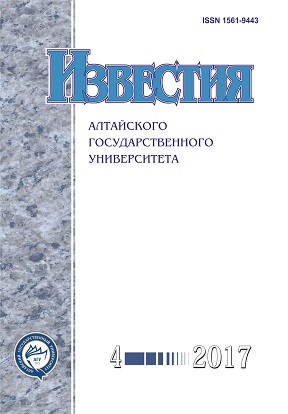Numerical Solution of Two-Dimensional Filtration Problem in the Upper Layers of Soil Considering Suffosion Processes
Abstract
In this paper mathematical model of isothermal internal erosion without deformation of porous medium is studied. Removal of soil particles from flow occurs at a certain magnitude of velocity of filtration. Equations of mass conservation of water, moving solids and stationary porous skeleton along with Darcy’s law for water and moving solid particles and equation for the intensity of suffusion aquifer were used as the mathematical model of the problem. Formulation of the problem and development of the system of equations are described in section 1. The results are parabolic equation with extinction of solution, elliptical equation for pressure and equation of the first order for the porosity of the soil. There is analogy with the classical Masket-Leverett model. Algorithm of numerical solution of two-dimensional initial boundary value problem of internal soil erosion proposed in section 2. The results of numerical investigation of the problem presented in section 3. We found the region of most susceptible to internal suffosion.
DOI 10.14258/izvasu(2017)4-27
Downloads
Metrics
References
Vieira D.A.N., Dabney S.M. Modeling edge effects of tillage erosion // Soil Tillage Research. - 2011. 111(2).
Wilson G. Understanding soil-pipe flow and its role in ephemeral gully erosion // Hydrol. Process. - 2011. - Vol. 25.
Einstein H. A. Der Geschiebetrieb als wahrscheinlichkeits Problem. Mitt. d. Versuchsanstaltf Wasserbau, Eidg. T. H. - Zurich, 1937.
Bonelli S. Erosion of Geomaterials. UK, 2012.
Vardoulakis I., Stavropoulou M., Papanastasiou R. Hydro-Mechanical Aspects of the Sand Production Problem // Transport in Porous Media. - 1996. - 22.
Wang J., Walters D. A., Settari A., Wan R. G. Simulation of cold heavy oil production using an integrated modular approach with emphasis on foamy oil flow and sand production effects 1st Heavy Oil Conference. - 2006.
Papin A. A., Sibin A. N. Model isothermal internal erosion of soil // J. Phys.: Conf. Ser. - 2016. - V. 722(1).
Самарский А.А., Николаев Е.С. Методы решения сеточных уравнений. - М., 1978.
Chetti A., Benamar A., Hazzab A. Modeling of Particle Migration in Porous Media: Application to Soil Suffusion // Transport in Porous Media. - 2016. - V. 113(3).
Сибин А.Н., Сибин Н.Н. Расчет физических характеристик почвогрунтов в процессе внутренней эрозии // МАК: Математики - Алтайскому краю : сборник трудов Всероссийской конференции по математике. - Барнаул, 2017.
Copyright (c) 2017 А.Н. Сибин, Н.Н. Н.Н.

This work is licensed under a Creative Commons Attribution 4.0 International License.
Izvestiya of Altai State University is a golden publisher, as we allow self-archiving, but most importantly we are fully transparent about your rights.
Authors may present and discuss their findings ahead of publication: at biological or scientific conferences, on preprint servers, in public databases, and in blogs, wikis, tweets, and other informal communication channels.
Izvestiya of Altai State University allows authors to deposit manuscripts (currently under review or those for intended submission to Izvestiya of Altai State University) in non-commercial, pre-print servers such as ArXiv.
Authors who publish with this journal agree to the following terms:
- Authors retain copyright and grant the journal right of first publication with the work simultaneously licensed under a Creative Commons Attribution License (CC BY 4.0) that allows others to share the work with an acknowledgement of the work's authorship and initial publication in this journal.
- Authors are able to enter into separate, additional contractual arrangements for the non-exclusive distribution of the journal's published version of the work (e.g., post it to an institutional repository or publish it in a book), with an acknowledgement of its initial publication in this journal.
- Authors are permitted and encouraged to post their work online (e.g., in institutional repositories or on their website) prior to and during the submission process, as it can lead to productive exchanges, as well as earlier and greater citation of published work (See The Effect of Open Access).








